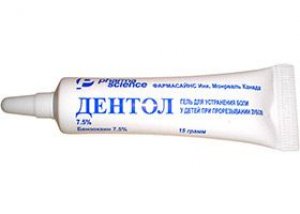
All iLive content is medically reviewed or fact checked to ensure as much factual accuracy as possible.
We have strict sourcing guidelines and only link to reputable media sites, academic research institutions and, whenever possible, medically peer reviewed studies. Note that the numbers in parentheses ([1], [2], etc.) are clickable links to these studies.
If you feel that any of our content is inaccurate, out-of-date, or otherwise questionable, please select it and press Ctrl + Enter.
Dentol
Medical expert of the article
Last reviewed: 03.07.2025

Dentol is a gel for gum treatment. It belongs to the group of local anesthetics.
ATC classification
Active ingredients
Pharmacological group
Pharmachologic effect
Indications Dentol
Gel 7.5% is indicated:
- for immediate relief of pain in infants aged 4 months and older (during the period of appearance of baby teeth);
- as a quick-acting, temporary remedy for toothache in young children;
- as an anesthetic during dental procedures, and also for minor injuries to the oral mucosa;
- in the complex treatment of aphthous stomatitis.
Gel 10% is prescribed:
- for prompt relief of toothache in children over 6 years of age, as well as adults;
- as a temporary analgesic for minor injuries to the oral mucosa, as well as for pain in the gums;
- in the form of an anesthetic for short dental procedures.
Release form
Available in gel form (7.5 and 10%) in 15 g tubes.
Dentol 7.5%. 1 g of the preparation contains 75 mg of the active ingredient – benzocaine. Among the auxiliary elements: glycerin, PEG-75, PEG-8, E954 (sodium saccharinate), vitamin C, water, and red dye with cherry flavoring.
Dentol 10%. 1 g of the medicine contains 100 mg of the active substance – benzocaine. The auxiliary substances are the same as in Dentol 7.5%, but without dye.
 [ 1 ]
[ 1 ]
Pharmacodynamics
Benzocaine, which is the active component of the drug, is a local anesthetic. It prevents the passage of nerve impulses, and at the same time strengthens the resistance of cell membranes under the influence of sodium ions - this allows for complete anesthesia of the mucous membranes and skin.
Pharmacokinetics
The gel's effect begins within 1 minute after its application. The duration of the medicinal effect is 20 minutes. The absorbed gel is quickly broken down by hydrolysis (with the participation of blood plasma cholinesterases, and, to a lesser extent, liver cholinesterases) to the state of decay products containing vitamin H1. The excretion of the drug is carried out by the kidneys, usually in the form of decay products.
Dosing and administration
Before starting the procedure, you need to wash your hands. After that, you need to unscrew the tube cap and cut off the adhesion on the hole. Apply a small amount of gel to the gums - you need to treat the area where the teeth are cutting through.
When used to relieve toothache, the medicine is applied to the area around the problem tooth.
The procedure can be performed 3-4 times a day. It is not recommended to use the medicine for more than 1 week in a row.
 [ 8 ]
[ 8 ]
Use Dentol during pregnancy
It is prescribed to pregnant women only if the benefit to the mother is considered to outweigh the risk of adverse effects on the fetus.
Side effects Dentol
Medicines containing benzocaine (2-10%) are generally well tolerated. They do not have an irritating effect and are non-toxic.
The side effect is mainly caused by the patient's hypersensitivity to the drug or exceeding the permissible dose of the drug. If the patient experiences swelling, itching or hyperemia in the area of gel treatment, the use of the drug must be discontinued.
 [ 7 ]
[ 7 ]
Overdose
The use of the drug in the required quantities excludes the possibility of overdose. But if there are multiple mucosal lesions in the mouth, and the dose of the drug was greatly exceeded, its absorption may increase, as a result of which the concentration of the active substance in the blood serum will increase. As a result, swelling, itching or hyperemia may appear at the treatment site. Suppression or stimulation of the central nervous system function, suppression of the cardiovascular system, and the development of methemoglobinemia are observed sporadically.
If the patient experiences such symptoms, it is necessary to rinse the mouth with a soda solution (warm), and then consult a doctor.
Interactions with other drugs
Dentol is prohibited to be combined with sulfonamides, as well as with CE inhibitors. The latter are capable of inhibiting the process of benzocaine metabolism, thereby increasing the likelihood of systemic intoxication. At the same time, benzocaine itself has the ability to inhibit the antibacterial activity of sulfanilamide drugs.
Storage conditions
The medicine must be kept in standard conditions and inaccessible to small children. The temperature must be within 15-30°C.
 [ 11 ]
[ 11 ]
Shelf life
Dentol can be used for 4 years from the date of release of the gel.
Manufacturer
Attention!
To simplify the perception of information, this instruction for use of the drug "Dentol" translated and presented in a special form on the basis of the official instructions for medical use of the drug. Before use read the annotation that came directly to medicines.
Description provided for informational purposes and is not a guide to self-healing. The need for this drug, the purpose of the treatment regimen, methods and dose of the drug is determined solely by the attending physician. Self-medication is dangerous for your health.

